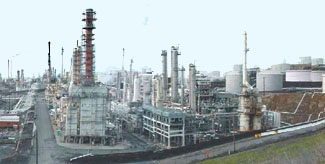Bacillus anthracis: Difference between revisions
imported>Kahtan M Alsaedi |
imported>Kahtan M Alsaedi |
||
| Line 9: | Line 9: | ||
Kingdom-Bacteria | Kingdom-Bacteria | ||
Phylum-Firmicutes | Phylum-Firmicutes | ||
Class-Bacilli | Class-Bacilli | ||
Order-Bacillales | Order-Bacillales | ||
Family-Bacillaceae | Family-Bacillaceae | ||
Genus-Bacillus | Genus-Bacillus | ||
Species-B. anthracis | Species-B. anthracis | ||
Revision as of 16:33, 28 March 2008
Articles that lack this notice, including many Eduzendium ones, welcome your collaboration! |
Classification
Higher order taxa
Kingdom-Bacteria
Phylum-Firmicutes
Class-Bacilli
Order-Bacillales
Family-Bacillaceae
Genus-Bacillus
Species-B. anthracis
Species
Description and significance
Describe the appearance, habitat, etc. of the organism, and why it is important enough to have its genome sequenced. Describe how and where it was isolated. Include a picture or two (with sources) if you can find them.
Responsible for causing anthrax, Bacillus anthracis is a large, rod shaped bacterium. Under ideal conditions, Bacillus anthracis organisms are surrounded by a gel-like covering called a capsule. Its this coating that protects it from the immune systems of a host animal. Anthrax organisms usually range in size from about 1 to 1.5 microns in width and about 3 to 10 microns in length.
Life cycle of Bacillus anthracis
Exposure to harsh conditions such as the death and decompositon of a host results in the anthrax bacteria forming spores. The process of spore formation is dependent on oxygen and thus does not occur in intact corpse. Once spores are formed they are highly resistant to drought, heat, cold, disinfectant, and other unfavorable surroundings. The high restivity of spores is due to hardy, thick-walled, oval bodies that have an average diameter of about 1-3 microns. Its these characteristics that allow spores to lie dormant in natural envirnoments for hundreds of years. The life cycle continues Once the spores are taken up by an animal which then allows them to transform back into rod-shaped bacteria. The bacteria then begin to mutiply and spread through the creature's body. Overtime huge population of germs develop and produce toxin, thus resulting in the host's death, and refomation into spores.
Genome structure
Describe the size and content of the genome. How many chromosomes? Circular or linear? Other interesting features? What is known about its sequence? Does it have any plasmids? Are they important to the organism's lifestyle?
Cell structure and metabolism
Describe any interesting features and/or cell structures; how it gains energy; what important molecules it produces.
Ecology
Describe any interactions with other organisms (included eukaryotes), contributions to the environment, effect on environment, etc.
Nearly all warm-blooded animals are vulnerable to anthrax. Some of anthrax victims are herbivores especially grazing animals such as cattle and sheep. Anthrax is also seen in demosticated animals such as horses, mules, goats and camels. Anthrax is not limited to just domesticated animals, its also seen in wild animals. On the other hand colded animals are not affected by anthrax at all. The reason for this is because Bacillus anthracis bacteria grows best at temperatures ranging from 77F to 104F. Animals whose body temperature does not fall with in the range will be immune to anthrax. A good example of an animal whose body temperature is above the permissible range for Bacillus anthracis and is thus immune to anthrax is a bird.
Pathology
How does this organism cause disease? Human, animal, plant hosts? Virulence factors, as well as patient symptoms.
Anthrax can strike at any time, but the most frequent time period when many grazing animals usually get sick is during the dry summer months. Its this time period that available forage decreases. The spores will enter the animal body when it eats the grass along with its root. The coarse vegetation can cause small cuts and abrasions in the mouth, lungs, and intestine of a grazing animal allowing spores to enter the body.
Meat-eating creatures are also at risk of eating sproes. They can contract anthrax from consuming sick prey or infected carcasses. Anthrax spores can also be trasmitted by insect bites, infected water, dust blown off anthrax infected soil, and commercial feed made from infected animal carcasses.
Once infection occurs, the incubation period is usually between 3 and 7 days. The course of illness varies with the form of the disease and the animal infected.
Application to Biotechnology
Does this organism produce any useful compounds or enzymes? What are they and how are they used?
Current Research
Enter summaries of the most recent research here--at least three required
Fighting Anthrax with Flies
The toxcitiy of Anthrax is due to the secretion of three polypeptides: the Protective Antigen(PA), Lethal Factor(LF), and Edema Factor(EF). The PA is responsible for binding to the surface of target cells. This binding facilitates the relase of LF a metalloprotease that is shown to cleave six of seven Mitogen-Activated Protein Kinase Kinases (MAPKK's). The binding also facilitate the relase of EF a acalmodulin-dependent adenylate cyclase that convert ATP to cAMP. So inorder for the toxcity of anthrax to be felt by the organism, binding between receptors and PA must occur. Lack of binding, Anthrax effect won't be felt, and an organism will survive. Its this quality that Drosophila posses which allows them to survive. The lack of binding is due to the absence of genes that code for receptors in the genome. Regradless of this, Drosophila can be still used to study the effect of anthrax through direct expression of LF and EF. Directed expression allows for greater experimental control, flexibility, and specificity in manipulation of toxins actions invivo. The knowledge of LF and EF function in Drosophila, allows for the testing of known inhibitors and discovering of new drugs against anthrax toxin.
References
Giagtzoglou, N., Bellen, JH. "Fighting anthrax with Flies". Proceedings of the National Academy of Sciences (PNAS). 2006. Volume 103. no.9. p. 3013-3014

